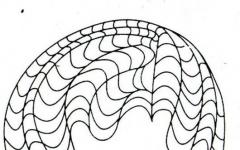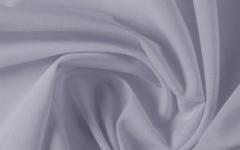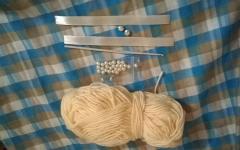It is impossible to sew trousers of a complex style without creating an individual pattern. However, it is quite possible to make simple bloomers in one evening. Fortunately, these wide-leg pants have been in fashion lately, and in combination with a fitted top they will look great on you. Bloomers will hide too full legs and give the image a special charm. In addition, similar clothes may be needed for oriental dance classes.
The basis of the future product will be a square piece of suitable fabric. The fabric for the summer should be perfectly draping, light: viscose, kashibo silk, satin. If you are preparing a dance costume or an oriental style outfit that you are going to wear with a skirt, it is acceptable to use chiffon.
Fold the square fabric in half along a diagonal line to form a scarf. The upper corner of the woven figure will be the waist line, the two lower opposite ones will be the slots for the legs. Trim and turn the hem of the waistband, form a drawstring and machine stitch it. Baste the connecting seam lines and machine stitch. All you have to do is thread the elastic band into the drawstring, remove the basting and steam the finished product.
Elasticated cuffs will add an oriental touch to summer trousers. For the drawstring, roll up the bottom of the trouser legs about 4 cm, stitch and thread the elastic band around the ankle. Sew open areas manually using a blind stitch.
Favorite pajamas instead of a pattern
Simple summer trousers can be made from elegant lightweight fabric using pajama pants of a suitable style as a basis. Carefully lay out a large piece of working fabric on a horizontal surface, wrong side up, securing it at the corners with tailor pins - this will prevent the fabric from slipping. Place the pajama pants on top, then very carefully trace the back side of the product with a sharp piece of soap.
When transferring the contours of pajama pants directly onto the canvas, it is better to use a pointed soap instead of a tailor's chalk. You don’t have to worry about making mistakes when making extra lines on the fabric - all marks will come off during the first wash.
Do the same manipulations with the second piece of the cut - transfer the contours of the front of the trousers. Please note that the back of the pants will be slightly larger than the front. Cut out both main parts of the product and use a sewing machine to sew all connecting seams. Overcast the edges by hand or with an overlocker, and sequentially work the bottom and top hems.
All you have to do is insert the elastic into the drawstring and your summer outfit will be ready. It can be worn both at home and for everyday walks. The knitted product is perfect for sports activities.
Trousers are so firmly established in women's wardrobes that it is difficult to imagine a time when only men wore them. Sewing casual pants and even formal business clothes to fit your figure is, contrary to the stereotype, not such a difficult task. To simplify the work as much as possible, you can not sew in a zipper or make a belt, but make an elastic band with a drawstring. Such trousers are sewn quickly, their pattern is simple, even a novice craftsman can successfully cope with this.
Modern catwalk trends have “legitimized” clothes with a semi-sports cut. It can be combined with everyday, office items, and can be used to create smart casual looks, adding fresh, daring and dynamic notes. Therefore, the possibilities of combining comfortable tight trousers with elastic bands have expanded significantly. They are no longer considered clothing exclusively for the home, cottage or country walk.
pompa.ru
By carrying out various manipulations with fabric, you can sew products for any occasion.
- Flowing materials with a smooth texture (silk, satin, chiffon) are suitable for making things in a fashionable “pajama” style, and if you add elastic at the bottom of the trousers, you get a “harem” model.
- Denim and thick textiles based on flax or wool are suitable for creating clothes for the cold period, in an “urban” or casual style.
- You can make office or evening trousers from cotton fabric that holds its shape well. An elastic band neatly sewn along the waistline, a close-fitting cut and a tapered hem will give the product a strict and classic look.
In the process, you don’t need to waste time sewing on zippers with valances, but you can, if desired, make pockets. Instead of an elastic band, sometimes a ribbon is inserted, which is tied with a beautiful bow. With its help, you will be able to perform two tasks at once: adjust the width and fit and add femininity and decorativeness to the product. Trousers, tailored to the figure, properly fitted and made of spectacular fabric, are in no way inferior to classic ones with a belt and tucks. They can be combined with loose shirts and business blouses, jackets and T-shirts. In addition, you can spend the whole day in them without feeling discomfort.
Getting started
To sew trousers with elastic, you need to use the base pattern, making small changes to it. Basic drawings created according to specific dimensions always come to the aid of craftsmen. If there is a basis, you can design any model based on it - from pajama and sports to evening and formal. Children's trousers and jeans are often sewn using a basic pattern, adding patch pockets, embroidery, and decor to the product.

pinterest.com
To make a basis for design, you need to accurately take measurements. Basic pattern for women's trousers with elastic - fitting fairly close to the lines of the body. It’s easy to expand it if you need a freer option.
To create a drawing you need to take measurements:
- waist and hip circumferences - OT and OB, at the thinnest point of the waist and the most convex points of the hips, respectively;
- knee circumference - OK;
- width at the bottom - ШН;
- side seam length - DB, from waist to floor;
- hip height (seat) - BC, from the waist to the subgluteal folds; it is calculated by sitting on a hard chair and drawing a vertical line from waist level to the seat;
- step length (LS) - it is calculated by subtracting the BC value from the DB value;
- knee height - VK, half the step length minus 1/10 of it;
- width along the front half (Shppb) - you need to subtract a centimeter from 1/4 OB;
- width in half at the back (Shpzb) - to 1/4 OB, on the contrary, you need to add a centimeter plus an increase for a loose fit of up to 10 mm.
The pattern of trousers with an elastic band is drawn on a sheet according to a template drawing, in which the upper horizontal line marks the waist level, and the perpendicular to it marks the conventional axis of ironing. It is necessary to sequentially model first the front and then the back halves of the base. Then it is adjusted to fit the model with an elastic band.

odensa-sama.ru
Constructing the front half of the base
Reference point A is marked on a sheet of paper in the upper left corner, closer to the edge. You need to extend the vertical from it by 1-1.5 centimeters to reflect the lateral rise, taking into account the “steepness” of the hip. The rule is simple: the greater the convexity/difference, the greater the value measured. The end of the segment is designated as B. From it you need to set the vertical down by the length of BC, marking it with point B. The segment from B to the next mark K is the height of the knee according to the measurement.
The side line is measured from B, the end of the segment is point N. B-N is the length of the product along the side. The horizontal line H-H1 drawn from point H shows how much the length needs to be reduced. Its size depends on the chosen model and is up to 4 cm. The product can also be lengthened to be worn with high heels. Now you need to draw the line of the hips from point B to the new mark B1. The segment B-B1 will be equal to 1/10 of the semicircle of the thigh, not counting the increase of about 3 centimeters.
Work progress
- Draw horizontal lines from marks B, B1, K and K1.
- On the line from B1, a segment B1-B2 is obtained, equal to Shppb.
- From B2, set the step width along the front half (1/10 OB plus 5-20 mm, depending on the desired degree of fit - from tight to loose).
- Draw a perpendicular axis along B2, on which marks A1 and C are placed.
- Mark the center of the segment B1-B3 - B4.
- Measure the segment H1-H2, equal to the value B1-B4. Arrows will follow points H2 and B2 on the front half of the product, ending at the waist line with marks A2 and H2.
- The segments H2-H3 and H2-H4 are measured - a quarter of the shn, reduced by a centimeter.
- Draw perpendiculars to the bottom line from points H3 and H4 - the segments to marks P and P1, respectively, will be equal to 4-8 cm.
- The segments B1-P and B3-P1 are measured - marks C1, K2 and K3 are formed.

modistka.net
Then you need to measure the segment from A1 to A3 (5-10 mm) and set aside 0.5 cm from B2 to the right. Draw a line from C to C2 so that it is equal to half the value of C-C1. Points C1 and C2 need to be connected, and then an auxiliary segment from A3 should be drawn to the resulting axis. The outlines of the bow are also drawn through this mark - in a straight line, and then using a pattern.
When calculating darts for a better fit, you need to lay out a segment from A3 to the new mark A4, equal to ¼ OT with the addition of 15-25 mm for the solution and up to 5 mm for the fit. Next, A4 should be connected to B1, and using a pattern, decorate the front half along the waist. From segment A2-B1, draw a perpendicular towards the thigh and draw a dart - depth up to 2.5 cm, length up to 10 cm. Its end is directed to the left side.
The middle seam on it is raised by 3 mm. If you need to narrow the trouser legs at the knee, draw a straight line from it downwards, and make it slightly concave upwards.
Rear design
The construction of the rear part is based on the drawing of the front half. It is necessary to draw the needle 1-2 centimeters (B4-B5), from its end draw a dotted line B5-K1 and measure from B5 to B6 ¼ of the value Shpzb. You will need a segment V-G - its value is determined by the shape of the buttocks. For a noticeable bend, measure about 3 cm, for a smooth curve or wide legs - 5-6 cm.

scrap-tag.ru
Points G and B6 need to be connected, and from the latter draw a line perpendicular to the G-B6 axis. The waist and hip line continues to the right and left. The segment from G1 to G2 on the hip line will be equal to Шзпб. This is a parallel to G-V6. The values of V5-G3 and V5-G2 must be equal to each other.
Construction progress:
- parallel outlines of the side and step cuts are drawn (at a distance of 20 mm) - points K4, k5, P2, P3, H5 and H6 are obtained;
- continue the segment K4-G2 to the waist level and put a T mark on it;
- connect K5 to G3, K1 to T, T and T1;
- carry out segments T1-T2 (up to a centimeter) and T2-T3 - ¼ FROM plus 30-40 mm for the dart and up to 5 mm for the fit;
- transfer the side cut along the length from the front half, but the side line can be slightly above waist level;
- draw an axis along the waist and make darts along the back half - up to 14 cm in length and up to 4 cm in depth;
- draw a slightly concave crotch seam along the back and shape the middle seam using patterns.
The finished drawing can be changed depending on the model. Sew trousers using the base once, and in the future you will easily create original and more complex variations.
Designing a model with an elastic band
The pattern of trousers with elastic, which is obtained from the modeled base, is constructed according to a similar principle. First you need to continue the lines of the hip and waist to the left, setting aside 2 centimeters on them. Then draw new outlines using a pattern. From the waist level up, 3 cm are put aside for the belt and hem, downwards along the side line 14 cm (for entering the pocket). His burlap is modeled as one-piece with a side and re-shot separately. You need to cut off the flange from the front part pattern, since it is not used when cutting.

anna-armen.com
The back is designed similarly to the front. They put 2 cm on the sides to get new outlines. A one-piece belt of the same width is built from the waist, including the hem.
The result should be 2 parts each:
- before;
- back;
- one-piece barrel with burlap;
- burlap pocket (it is cut from lining fabric).
The bottom of the trouser legs can also be decorated with an elastic band by making a hem. It will “take away” part of the length, so when modeling the pattern you need to take into account the margin by adding 10 cm on the front and back half. It is advisable not to skimp on fabric so that at the last fitting, when adjusting the length of the product, the bottom can be adjusted correctly.
I was often asked to post a master class on sewing trousers and sleep masks. I wouldn’t dare to call what’s described below a master class, because I’m not a professional seamstress and often sew on a whim, and not according to exact measurements and patterns, but still, I’m almost always completely satisfied with the result.
I guarantee you a fun time and an interesting experience :)
We will need:
1. Glasses (to determine the desired shape of the mask)
2. Paper for making the base
3. Scissors
4. Fabric for the outer part of the mask (I chose lace)
5. Fabric for the inside of the mask (it is better to take natural material)
6. Soft fabric for lining (some people choose cardboard or paper, but, unfortunately, such a mask cannot be washed. I chose a piece of cotton wool - it’s soft and comfortable, and can be washed. You can take padding polyester or 2 layers of thick fabric)
7. Marker
8. Elastic band
9. Tape for measuring mask parts
10. Threads
11. Braid (optional, depends on the design of the mask itself)
12. Long piece of fabric for covering the elastic
We outline the glasses with a marker, giving the desired shape. I wanted the edges to be slightly curved up like a cat eye.
Transfer the pattern to the fabric. I need the bottom piece of white silk to serve as a base for the lace. For the inner side I took a nice cotton material. You can choose fleece.
To prevent the cotton wool from ruining the shape of the mask when washing, we sew it on a machine.
Sew the lace to the base - silk fabric. We cut the cotton to give the desired shape.
We fold the parts in the required order, wrong side up: first the lace, then the fabric for the inside, then the cotton padding. Prepare a thin long strip of fabric (2 times longer than the elastic), sew it, turn it inside out and use a pin to thread the elastic into it. I sewed the braid separately, by hand, to make it more neat. We're ready to stitch the pieces together!
We sew the parts together in the sequence described above, leaving a small hole for turning the mask inside out. After turning it inside out, carefully sew up the hole.
Sew on the braid and...
Our mask is ready:) Sweet dreams!
We sew pajama pants
We will need:
1. A piece of fabric with your favorite pattern
2. Scissors
3. Measuring tape
6. Needles for preparing the pattern
7. Scissors
8. House pants, which you will use as the basis for the pattern.
We fold the fabric along its length (you just need to do this by turning the fabric inside out, and not like me:) to a width equal to the width of the trousers. We put on the trousers, folded lengthwise (we only need one “half-butt”), trace them with chalk or pin them with needles, and immediately cut them out.
We got a wonderful pattern for one part of the trousers. Fold the fabric lengthwise on the other side to a width equal to the width of the finished pattern and cut it out.
By Marina Pankratieva 10/31/2017
Men's trousers in an hour How to sew homemade trousers with elastic based on a pattern of classic trousers
Men's trousers in an hour How to sew homemade trousers with elastic based on a pattern of classic trousers. Men's trousers with a simplified cut are the topic of our video. We have a course on designing and sewing men's trousers. Many have already purchased this course for themselves, they share in the comments how they did it, that they are satisfied, maybe some of you have your own basic pattern for the basis of men's trousers.
But very often it happens that you need to sew something very quickly and simply, “in a hurry,” as they say. For example, how you and I sewed a skirt with an elastic band*. In order for us to be able to sew men's trousers with elastic for the country house, for the beach, for relaxation, something simple and practical for relaxation and for the home in an hour, we need a basic pattern for men's trousers.
men's trousers "quickly" based on the basic pattern of men's trousers
So, today we will figure out how to cut and sew homemade men's trousers using a simplified technology based on a pattern of classic trousers. Our trousers will have a simplified cut without a side seam and with elastic.

basic pattern for men's trousers
Here is the basic trouser base. The front halves of the trousers are outlined in red and the back halves of the trousers are outlined in green, but this pattern is very difficult to sew, so this pattern is not suitable for us now. Now I will show you how to use this pattern to make a pattern for an easy-to-make version of trousers. From the base pattern we remove the front and back halves of the trousers.

lay out the pattern on the fabric

from the base base we re-take the pattern of the back and front panels
Since we have mock-up fabric and I don’t see the point in buying two lengths for such a lesson, and if we lay out the patterns on the fabric, it’s not enough for us, so I slightly changed the canvas by hemming the missing piece of fabric where I didn’t have it for laying out the pattern, see photo When you will buy fabric, see in advance how much you need - one or two lengths of fabric.

the missing piece of fabric for the training layout is simply added
After this, we connect both parts of the pattern so that they coincide along the bottom line of the trousers, see photo

along the bottom line, the pattern pieces must match
After the bottom has been leveled, it is necessary to align it along the top line, the patterns along the hip line are slightly on top of each other, see photo, we will add this distance later
in the meantime, you need to attach the pattern to the fabric (pin it with pins)

align the pattern along the top line and place them along the hip line
Since our trousers will have an elastic band, and we have slightly removed the volume along the hips (so that there is not a very large width along the side seam line when combining two pattern pieces), we need to return this volume and add more to it.

This is what the pattern looks like on the fabric
To do this, we need to make a cut along the ironing line on the paper pattern and expand the pattern to a width that takes into account what we lost when applying the pattern and for additional freedom to use an elastic band, we add width as desired, look at the photo, How far did I spread the pattern?

cut the pattern of the front panel along the drawstring line

spread the pattern to the required width along the bottom line and along the top line
You can also move it wider along the bottom line. When you buy fabric, see in advance how much you need - one or two lengths of fabric.
In the same way, it is necessary to open the back half of the trousers: randomly, approximately in the center, cut the pattern and spread it apart, secure it with pins on the fabric so that it is convenient to cut. We don’t spread it too far apart, since loose trousers that are too wide won’t look very good either.

open the back half of the trousers in the same way as the front
All we have to do is cut out one piece (the fabric is folded in half), sew one instep seam in the middle, and assemble the top with an elastic band and the trousers will be ready in an hour! For those who like pockets, you can make a patch pocket**. Now we need to add 4 cm along the top line so that we can sweep and insert the elastic.

along the top line add 4 cm in order to create a hem and thread the elastic
When cutting, pay attention to this area - leave a little more seam allowance in this place so that there is more room there too.

when cutting, pay attention to this area
We basted the first and second step seam, now you will see what our trousers will look like, of course, it is best to sew right away and not baste, but it’s still inconvenient for me, since the equipment is turned off, but I want to show you the principle, so I’m basting.
And you need to mark with a notch where the front part is, then set aside 6 cm for the elastic, fold it in half and iron it. The elastic can be threaded with a pin or a special rubber threader; it is very simple and convenient to use.

rubber bander

we make a hem for the elastic and thread the elastic
These trousers are very comfortable - one crotch and one middle seam, overlock, elastic and trousers are ready! These are the trousers we came up with for home and leisure!








